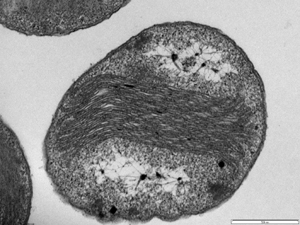Nitrosococcus oceani , an Obligate Lithoautotrophic, Ammonia-Oxidizing Bacterium in the World's Oceans The ammonia-oxidizing bacterium Nitrosococcus oceani ATTC 19707 (Bacteria, Proteobacteria, Gammaproteobacteria, Chromatiales, Chromatiaceae , Nitrosococcus , Nitrosococcus oceani ) was the first ammonia-oxidizing bacterium isolated by enrichment culture from seawater, named Nitrosocystis oceanus , and it resembled the original type strain, Nitrosococcus winogradskyi 1892, which had been lost. As a member of the order Chromatiales, the purple sulfur bacteria, N. oceani is a member of the evolutionarily oldest taxonomic group capable of lithotrophic ammonia catabolism. Nitrosococcus oceani and N. halophilus are the only known species of gammaproteobacterial ammonia-oxidizing bacteria (AOB). All other cultivated aerobic AOB are Betaproteobacteria, and their members have been detected in soils, freshwater and sediments as well as marine environments. In contrast, gammaproteobacterial AOB have only been found in marine or saline environments. Nitrosococcus oceani has been detected in many marine environments using immunofluorescence, and more recently on the basis of cloned gene sequences from DNA extracted from natural seawater. In addition to the truly marine environment, N. oceani was detected by immunofluorescence and fluorescent in situ hybridization (FISH) in the saline waters of Lake Bonney, a permanently ice-covered lake in Antarctica. Nitrosococcus halophilus has been isolated only from saline ponds and has not been detected in other environments by using molecular probes. Nitrosococcus oceani plays an important Role in the Nitrogen Cycle in the World's Oceans The general role of nitrifying bacteria in marine systems is to link the oxidizing and reducing processes of the nitrogen cycle by converting ammonium to nitrate. This conversion is responsible for maintaining the major component of the fixed nitrogen pool in the oceans, nitrate, which is present nearly everywhere below a few hundred meters at concentrations approaching 40 µM. The deep nitrate reservoir of the oceans is a huge pool of nitrogen whose availability to primary producers in the surface layer is controlled still largely by physical processes. The nitrification process produces oxidized forms of nitrogen that are lost via denitrification and anaerobic ammonia oxidation (anammox). By converting nitrogenous compounds released as waste products of metabolism into NO x intermediates that can act both as an oxidant and a reductant for the fixed N removal processes, nitrification closes the global nitrogen cycle. Nitrification occurs in both the water column and in sediments of marine environments. In sediments, nitrification is often tightly coupled with denitrification, and can account for a significant fraction of the total oxygen consumption in sediments. The susceptibility of AOB to inhibition by sunlight (due to the light sensitivity of ammonia monooxygenase; AMO, and associated cytochromes) is probably responsible for the characteristic distribution of nitrification in the water column; maximal rates occur in surface waters near the bottom of the euphotic zone. Nitrification rates decrease with increasing depth as the rate of organic matter decomposition (and thus ammonium supply) decreases with depth. Nitrosococcus oceani a major Producer of Greenhouse Gas in the World's Oceans As a consequence of both nitrifier and denitrifier activities, the oceans emit large amounts of the greenhouse gas nitrous oxide . The total oceanic N 2 O inventory is about 2/3 the size of the total atmospheric inventory and the oceanic N 2 O flux to the atmosphere is estimated to be 4 Tg N/year. Recent geochemical evidence indicates that most of the N 2 O in the ocean is derived from nitrification ; therefore, the detailed understanding of the marine nitrification process is crucial for any global management strategy of greenhouse gas production. This significance of nitrification in the oceans and its indirect influence on the oceanic carbon budget led to the selection of N. oceani ATTC 19707 as a target for genome sequencing in the Genomes to Life microbial sequencing program of the US Department of Energy. |
||
|
||
Nitrosococcus oceani C-107, ATCC 19707

